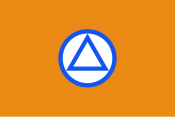
Back فلامس نيشنال فيربوند Arabic Фламандскі нацыянальны саюз Byelorussian Flamanska nacionalna unija BS Unió Nacional Flamenca Catalan Flämischer Nationalverband German Unión Nacional Flamenca Spanish Ligue nationale flamande French Flamanska nacionalna unija Croatian Vlaamsch Nationaal Verbond ID Unione Nazionale Fiamminga Italian
Flemish National Union Vlaamsch Nationaal Verbond | |
|---|---|
 | |
| Leader | Staf De Clercq (until 1942) Hendrik Elias (from 1942) |
| Founded | 8 October 1933 |
| Dissolved | 2 September 1944 |
| Preceded by | Frontpartij |
| Headquarters | Brussels, Belgium |
| Newspaper | Volk en Staat |
| Youth wing | Nationaal-Socialistische Jeugd in Vlaanderen[1] |
| Paramilitary wing | Diets Militia—Black Brigades |
| Membership | 25,000 (1939 est.)[2] |
| Ideology | Flemish nationalism Greater Netherlands (until 1940)[3] Corporate statism[4] Right-wing populism |
| Political position | Far-right[5] |
| French-speaking counterpart | Rexist Party (1936–1937)[6] |
| Slogan | "Authority, discipline, and Dietsland" |
| Party flag | |
 | |
The Vlaamsch Nationaal Verbond (Dutch pronunciation: [ˈvlaːms nɑ(t)ɕoːˈnaːl vɛrˈbɔnt], "Flemish National Union" or "Flemish National League"), widely known by its acronym VNV, was a Flemish nationalist political party active in Belgium between 1933 and 1945.[7] It became the leading force of political collaboration in Flanders during the German occupation of Belgium in World War II. Authoritarian by inclination, the party advocated the creation of a "Greater Netherlands" (Dietsland) combining Flanders and the Netherlands.
- ^ Witte, Els; Craeybeckx, Jan; Meynen, Alain (2010). Political History of Belgium: From 1830 Onwards. Asp / Vubpress / Upa. pp. 203–204. ISBN 978-90-5487-517-8.
- ^ VLAAMS NATIONAAL VERBOND (VNV). www.belgiumwwii.be.
- ^ DBNL. "Maurice de Wilde, België in de Tweede Wereldoorlog. Deel 3 · dbnl". DBNL (in Dutch). Retrieved 2021-07-03.
- ^
Badie, Bertrand; Berg-Schlosser, Dirk; Morlino, Leonardo, eds. (7 September 2011). International Encyclopedia of Political Science. SAGE Publications (published 2011). ISBN 9781483305394. Retrieved 9 September 2020.
... fascist Italy ... developed a state structure known as the corporate state with the ruling party acting as a mediator between 'corporations' making up the body of the nation. Similar designs were quite popular elsewhere in the 1930s. The most prominent examples were Estado Novo in Portugal (1932–1968) and Brazil (1937–1945), the Austrian Standestaat (1933–1938), and authoritarian experiments in Estonia, Romania, and some other countries of East and East-Central Europe,
- ^ Witte, Els (2009). Political History of Belgium, from 1830 onwards. ASP. p. 157.
- ^ Cite error: The named reference
Capocciawas invoked but never defined (see the help page). - ^ Kinderen van de collaboratie. Ervaringen en getuigenissen van nakomelingen van collaborateurs in de Tweede Wereldoorlog. University of Ghent, 2010, Master thesis history